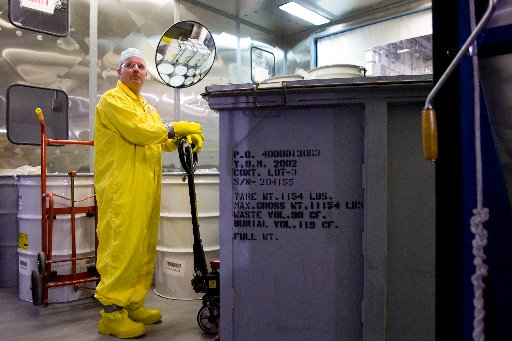Photo: Radioactive waste management facility at the US Y-12 Oak Ridge nuclear weapons plant (US Government open source)
A key facility for the treatment of radioactive waste from the production of nuclear weapons at the Atomic Weapons Establishment (AWE) at Aldermaston is two years behind schedule, and the Health and Safety Executive's Nuclear Installations Inspectorate (NII) has resorted to imposing 'special measures' reporting on AWE in an attempt to force the establishment to deliver the project on time.
Correspondence between AWE and the NII, released to the Nuclear Information Service under the Freedom of Information Act (see below), reveals that NII does “not have confidence that the project will be delivered to time”, and has ordered AWE to provide monthly written updates on progress with the project.
In March 2007 NII issued a Licence Instrument requiring AWE to reduce in volume and encapsulate at least 1000 205 litre drums of Intermediate Level Waste – waste which is too highly contaminated with radioactive material for disposal in existing facilities – by 20 February 2014. However, plans to build a Soild Intermediate Level Waste Treatment Plant at Aldermaston to reduce the volume of waste have slipped dramatically, with a recent review identifying a need for changes in the plant's design to address concerns about criticality, containment, and seismic withstand.
NII is concerned that safety documentation has not been delivered to meet AWE's own project timetable, and a pre-contruction safety review is now expected to be two years behind schedule. A request to undertake early civil engineering works for the project has “identified a number of technical and safety issues that impact on the proposed civil design”.
Following an update in August from AWE on progress with the project, the NII wrote to AWE's Director of Infrastructure to warn the company that “Although ND [HSE's Nuclear Directorate] acknowledge that AWE is undertaking significant additional effort on this project, ND is concerned about the amount of slippage in the delivery programme from the dates given in the April 2010 workshop. This includes AWE's ability to address the issues surrounding the DBA [design basis accident], relevant fault schedules, criticality, civil design and therefore suitability of location.”
In the letter NII emphasised that their concerns were “not about reducing the NII permissioning risk, but to ensure AWE has an adequate safety case that demonstrates it has undertaken all measures, so far as is reasonably practicable, to reduce the potential for harm to their workers and the public.”
Radioactive wastes have accumulated at AWE for sixty years since the site first began work on building the UK's arsenal of nuclear weapons in 1950. According to the UK Radioactive Waste Inventory, published in 2007, intermediate level wastes held at Aldermaston include wastes contaminuated with plutonium, tritium, and uranium, contaminated oils, decommissioning wastes from test reactors, and a number of closed radioactive sources. The inventory lists AWE's total holdings of intermediate level radioactive waste from operations and decommissioning as 4276.7 m3 in 2007, with a total of 9816.1 m3 estimated to be generated across the establishment's whole lifetime.
Intermediate level radioactive waste is stored in purpose built stores at AWE Aldermaston and will be held there indefinitely until a national radioactive waste repository for intermediate level waste is opened. As yet no suitable location for such a repository has been identified, and it is expected to be at least thirty years into the future before the repository will be open to receive wastes.
Steven Hendry of the independent Nuclear Information Service said: “NII are quite right to wave a big stick at AWE for failing to deliver on a crucial environmental programme.”
“Over recent months AWE has been moving full steam ahead to invest in state-of-the-art nuclear warhead research equipment and new warhead production facilities, but has put next to no effort into dealing with its ever-growing legacy of dangerous radioactive waste.
“Opening the Solid Intermediate Level Waste Treatment Plant is a vital first step towards tackling the sixty-year old backlog of radioactive waste which has piled up at Aldermaston, and the project should be given the highest priority by AWE.”
Read the correspondence between NII and AWE about the Solid Intermediate Waste Treatment Plant here:
